Wikipedia:Picture of the day/December 2009
|
Featured picture tools: |
These featured pictures, as scheduled below, appeared as the picture of the day (POTD) on the English Wikipedia's Main Page in December 2009. Individual sections for each day on this page can be linked to with the day number as the anchor name (e.g. [[Wikipedia:Picture of the day/December 2009#1]] for December 1).
You can add an automatically updating POTD template to your user page using {{Pic of the day}} (version with blurb) or {{POTD}} (version without blurb). For instructions on how to make custom POTD layouts, see Wikipedia:Picture of the day.Purge server cache
December 1

|
A Craticulina species fly found in Dar es Salaam, Tanzania. The species in this genus of true flies are parasites of the sand wasp. They do not lay eggs, but instead deposit their larvae on the food caught by the wasp for its own larvae, an act known as kleptoparasitism. Photo credit: Muhammad Mahdi Karim
Recently featured:
|
December 2

|
The Coronation of Napoleon, a painting by Jacques-Louis David depicting Napoleon Bonaparte's self-coronation as Emperor of France on December 2, 1804. The act took place in Notre-Dame de Paris, during which Napoleon, eschewing tradition, took the crown and placed it on his own head. The nearly 10 by 6 m (32.8 by 19.7 ft) work was commissioned before the coronation and completed in 1807. Painting by Jacques-Louis David and Georges Rouget |
December 3
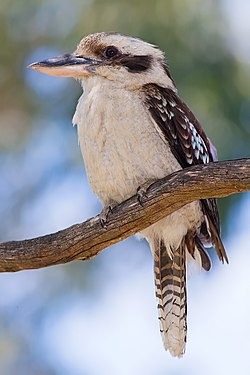
|
The Laughing Kookaburra (Dacelo novaeguineae) is a carnivorous kookaburra in the Kingfisher family well known for its laughing call. It is about 45 cm (18 in) in length and is found throughout eastern Australia and neighboring islands, and has been introduced to southwestern Australia as well as Kawau Island near New Zealand. Its trademark "laugh" is to establish territory amongst family groups. When one bird starts, often others will join in, including nearby birds from rival tribes, which can fill the bush with their calls. Photo credit: Fir0002
Recently featured:
|
December 4

|
A scene from a late-16th century publication of Nezami Ganjavi's adaptation of the classical Persian story Layla and Majnun, which is based on the real story of Qays ibn al-Mulawwah, a young man from the northern Arabian Peninsula and his love Layla. There are two versions of the story, but in both, Majnun goes mad when her father prevents him from marrying her. In the depicted scene, the eponymous star-crossed lovers meet for the last time before their deaths. Both have fainted and Majnun's elderly messenger attempts to revive Layla while wild animals protect the pair from unwelcome intruders. Artist: Unknown; Restoration: Lise Broer
Recently featured:
|
December 5
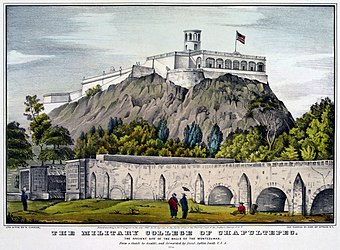
|
A ca. 1847 hand-tinted lithograph by Nathaniel Currier of the Heroic Military Academy, sited in Chapultepec Castle, a castle in Mexico City, Mexico. The castle is depicted in its state following the Battle of Chapultepec in the Mexican–American War, during which it was captured by the United States (as seen by the flag). It is now home to the Museo Nacional de Historia. Restoration: Lise Broer
Recently featured:
|
December 6
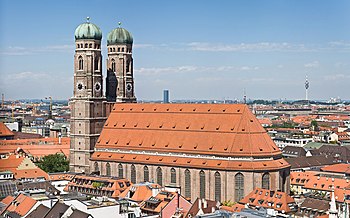
|
The Frauenkirche in Munich, Bavaria, Germany, the cathedral of the Archbishop of Munich and Freising, as viewed from the tower of the nearby St. Peter's Church. Construction of the church began in 1468 and was completed in 20 years, although the towers' domes were not finished until 1525. Photo credit: David Iliff
Recently featured:
|
December 7

|
A small launch rescues an overboard seaman alongside the burning battleship USS West Virginia, which was heavily damaged in the attack on Pearl Harbor, December 7, 1941. USS Tennessee is in the background, moored alongside. Completely rebuilt by 1944, West Virginia went on to participate in the Battles of Leyte Gulf, Iwo Jima, and Okinawa before being decommissioned in 1947 and struck in 1959. Photo: United States Navy; Restoration: Lise Broer
Recently featured:
|
December 8

|
An albino Bennett's Wallaby (Macropus rufogriseus rufogriseus), one of a number of albino individuals on Bruny Island, off the coast of Tasmania, Australia. Albinism is characterized by a partial or total absence of melanin pigment in the eyes, skin and hair, resulting from inheritance of recessive alleles. The condition is known to affect mammals (including humans), fish, birds, reptiles and amphibians. Albinism is sometimes confused with leucism, in which all integumental pigment is at least partially absent due to chromatophore defects. Photo credit: Noodle snacks
Recently featured:
|
December 9

|
The Mayor of Jerusalem Hussein al-Husayni (centre) meets with soldiers of the British Egyptian Expeditionary Force on December 9, 1917, under the white flag of surrender. The Battle of Jerusalem had begun the day before, but the Turkish forces in the city were no match against the British forces. A Turkish counterattack on December 25 was also repulsed, confirming the capture of Jerusalem by the Allies. Photo: American Colony; Restoration: Sebastian Kolendo
Recently featured:
|
December 10
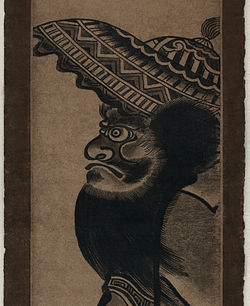
|
Detail from a Japanese woodblock print (ca. 1741–51) of Zhong Kui (called Shōki in Japanese), a Chinese mythological figure traditionally regarded as a vanquisher of ghosts and demons. His image is often painted on household gates as a guardian spirit, as well as in places of business where high-value goods are involved. According to folklore, Zhong Kui was a man who committed suicide after he was stripped of the title "zhuangyuan" (having achieved top honors in the imperial examinations) by the emperor of China because of his disfigured appearance, after which he became king of ghosts in Hell. The print is entitled "Shōki zu" ("Shōki striding") and measures 69 by 10 cm (27.2 by 3.9 in) Artist: Okumura Masanobu; Restoration: Lise Broer |
December 11

|
|
Two Red Delicious apples and a cross-section of a third. It was first recognized in 1880 as a red and yellow striped fruit known as a "Hawkeye". Through selective breeding over the years, new cultivars with improved color and earlier harvest time replaced the original, but only at the expense of the taste and texture. This caused consumer demand for Red Delicious apples to drop drastically in favor of other varieties such as the Cameo, Fuji and Gala. Photo credit: Fir0002
Recently featured:
|
December 12
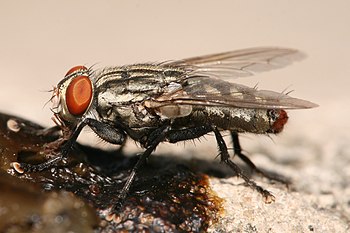
|
The genus Sarcophaga (S. bercaea shown here) is composed of an immense number of flesh-fly species that are found worldwide, almost all of which are nearly impossible to identify on sight. As the common name implies, their larvae typically feed on decaying flesh. Some, however, eat the bacteria and other small organisms living on carrion or feces, as seen here. Photo credit: Muhammad Mahdi Karim
Recently featured:
|
December 13

|
The Red Wattlebird (Anthochaera carunculata) is a large species of honeyeater found across southern Australia. Growing up to 35 cm (14 in) in length, it has distinctive red wattles, white streaks on the chest and belly, and a bright yellow patch towards the tail. Its diet consists mostly of nectar, but it will take insects as well as fruit. Photo credit: Mick Stephenson
Recently featured:
|
December 14

|
The eruption cloud of Mount Redoubt, an active stratovolcano found in the Chigmit Mountains of the U.S. state of Alaska, seen here from the Kenai Peninsula four months after it began erupting on December 14, 1989. This eruption was the first ever to be successfully predicted through the observation of long-period seismic events. Photo credit: R. Clucas, USGS
Recently featured:
|
December 15

|
Midway Geyser Basin and the Grand Prismatic Spring, a hot spring located in Yellowstone National Park in the U.S. states of Wyoming and Montana. The third-largest hot spring in the world, it is known for its vivid colors, which are the result of pigmented bacteria in the microbial mats that grow around the edges of the mineral-rich water. Photo credit: Mila Zinkova
Recently featured:
|
December 16

|
An engraving by James Caldwell, from a painting by Gavin Hamilton, of action from Act V, Scene III of William Shakespeare's 1608 play Coriolanus. The play, based on the life of the possibly legendary Roman general Gaius Marcius Coriolanus, was originally published in the First Folio of 1623, but its first known performance, an adaptation by Nahum Tate, did not take place until 1682. Restoration: Adam Cuerden
Recently featured:
|
December 17
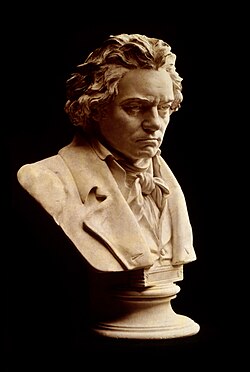
|
A bust of the German composer and pianist Ludwig van Beethoven (1770–1827), made from his death mask. He was a crucial figure in the transitional period between the Classical and Romantic eras in Western classical music, and remains one of the most acclaimed and influential composers of all time. Born in Bonn, of the Electorate of Cologne and a part of the Holy Roman Empire of the German Nation in present-day Germany, he moved to Vienna in his early twenties and settled there, studying with Joseph Haydn and quickly gaining a reputation as a virtuoso pianist. His hearing began to deteriorate in the late 1790s, yet he continued to compose, conduct, and perform, even after becoming completely deaf. Photo: W. J. Mayer; Restoration: Lise Broer
Recently featured:
|
December 18

|
|
A 1919 painting depicting the definitive design of the Lexington class battlecruiser, the only class of battlecruiser to ever be ordered by the United States Navy. Six were planned as part of the massive 1916 building program, but their construction was repeatedly postponed. Four of the ships were eventually canceled, and the remaining two (Lexington and Saratoga) were converted into the United States' first aircraft carriers. Artist: F. Muller; Restoration: Lise Broer
Recently featured:
|
December 19

|
Calliandra emarginata, native to tropical and subtropical regions of southern Asia, Africa, Australia and the Americas, is one of about 200 species of flowering plant in the Calliandra genus. The common name for Calliandra species is "Powder-puff plant" or "Fairy Duster" due to the globular arrangement of the long slender stamens in the flowers. Photo credit: UpstateNYer
Recently featured:
|
December 20
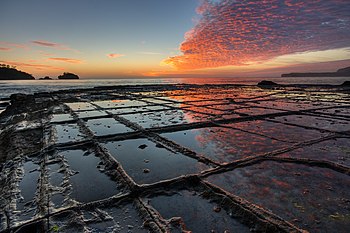
|
Sunrise on the tessellated pavement at Eaglehawk Neck, Tasmania. Tessellation (the tiled appearance) of flat-lying sedimentary rock may occur on some ocean shores when the rock fractures through the action of stress on the Earth's crust and is subsequently modified by sand and wave action. Photo credit: Noodle snacks
Recently featured:
|
December 21

|
A satellite image of the Scandinavian Peninsula in winter. The peninsula, approximately 1,850 kilometers (1,150 miles) long with a width varying between approximately 370–805 km (230–500 mi), making it the largest in Europe, is located in the northern part of the continent and consists of Norway, Sweden and part of Finland. Much of the population is concentrated in the southern part of the peninsula; Stockholm and Gothenburg, both in Sweden, and Oslo in Norway are the largest cities. Photo credit: MODIS Rapid Response Project, NASA
Recently featured:
|
December 22

|
A Chrysosoma species of long-legged fly (Dolichopodidae), a family of flies that has more than 7,000 described species in about 230 genera distributed worldwide. They are generally fairly small, metallic flies with large, prominent eyes, but despite the common name, not all species have long legs. Photo credit: Muhammad Mahdi Karim
Recently featured:
|
December 23
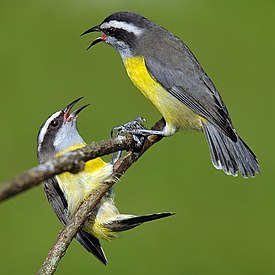
|
A pair of Bananaquits (Coereba flaveola), small passerine birds averaging 11 cm (4.3 in) in length native to tropical South America, Central America, and the Caribbean. Its curved beak is adapted to taking nectar from flowers, but they will also eat fruit and insects. Photo credit: Leon Bojarczuk
Recently featured:
|
December 24

|
The poster for D. W. Griffith's 1913 silent film Three Friends, distributed by Biograph. Griffith began his film career with Biograph in 1908 as a screenwriter and actor, but within months became the company's main director. His prolific output, often one new film a week, and willingness to experiment in many different genres helped the company become a major commercial success. However, Griffith left Biograph in October 1913 due to various disputes, taking many of its stars with him, and the company fell into financial difficulties. Its studios were acquired by one of its creditors, the Empire Trust Company. Restoration: Lise Broer
Recently featured:
|
December 25

|
"Sleigh Ride" is a popular light orchestral piece, composed by Leroy Anderson, often associated with Christmas, although the lyrics never specifically mention any holiday or religion. However, they do compare the feeling of a sleigh ride to a "picture print by Currier and Ives", such as this 1867 lithograph, entitled "A Brush for the Lead". Artist: Thomas Worth; Restoration: Lise Broer
Recently featured:
|
December 26
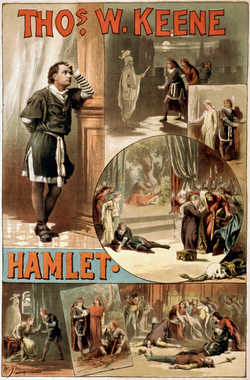
|
A ca. 1884 lithographed poster for an American production of William Shakespeare's Hamlet starring Thomas W. Keene. The play, believed to have been written between 1599 and 1601, recounts how Prince Hamlet exacts revenge on his uncle Claudius, who has murdered Hamlet's father, the King, and then taken the throne and married Gertrude, Hamlet's mother. Several key scenes from the play are depicted on the poster, including the initial meeting with King Hamlet's ghost (top right) and the exhuming of Yorick's skull (bottom center). Lithography: W.J. Morgan & Co.; Restoration: Adam Cuerden
Recently featured:
|
December 27
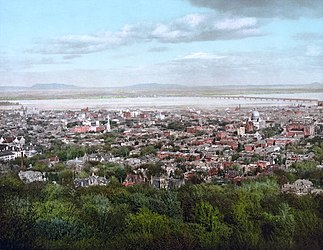
|
A photochrom print of Montreal, Quebec, Canada, in 1902. The history of Montreal spans some 8,000 years and began with the Algonquin, Wyandot, and Iroquois tribes of North America. A permanent French settlement was established in 1639, which transferred to British control in 1760. Image: Detroit Publishing Co.; Restoration: Lise Broer
Recently featured:
|
December 28

|
Pisaura mirabilis is a species of nursery web spider, so named because the female will build a nursery "tent" in which to put the egg sac. Males of this species in particular have been known to offer food to potential female mates. Some will even play dead: when the female approaches to take the food, the male springs back to life to attempt to mate. This gives the males over a 40% success increase of achieving copulation. Photo credit: Richard Bartz
Recently featured:
|
December 29

|
Corpses wrapped in blankets, three weeks after the Wounded Knee Massacre, which took place near Wounded Knee Creek, South Dakota, United States, on December 29, 1890. In what was supposed to be a peaceful transport operation, troops of the 7th Cavalry and contingent of Miniconjou and Hunkpapa Sioux (Lakotas) engaged in battle, resulting in the deaths of 146 Lakotas and 25 troopers. Photo: Trager & Kuhn; Restoration: Lise Broer
Recently featured:
|
December 30

|
Ryū sho ten ("Dragon rising toward heaven"), an 1897 ukiyo-e print by Ogata Gekkō showing a Japanese dragon moving upwards with Mount Fuji in the background. Dragon myths in Japanese folklore amalgamate native legends with imported stories from China, Korea and India. Most Japanese ones are water deities associated with rainfall and bodies of water, and are typically depicted as large, wingless, serpentine creatures with clawed feet. Restoration: Adam Cuerden
Recently featured:
|
December 31

|
The snowflake moray (Echidna nebulosa) is a moray eel found throughout much of the tropical portions of the Pacific Ocean at depths of between 2 and 30 m (6.6 and 98.4 ft). It grows up to 1 m (3.3 ft) long and is commonly kept in aquariums. Photo credit: Mila Zinkova
Recently featured:
|
Picture of the day archives and future dates
